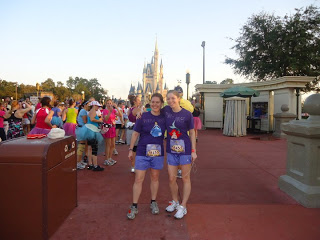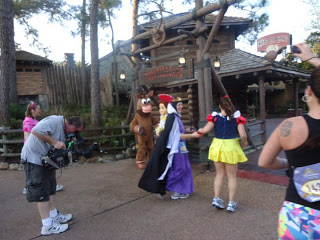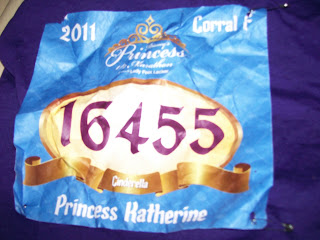You might have noticed in my previous post that my bib says “Cinderella” right above “Princess Katherine.” That’s because when we registered, we had to choose which of seven princesses was our favorite: Cinderella, Snow White, Aurora (from Sleeping Beauty), Ariel (from The Little Mermaid), Belle (from Beauty and the Beast), Jasmine (from Aladdin), or Tiana (from The Princess and the Frog).
The Disney princesses have gotten a lot of bad press, which has been amplified recently with the publication of Peggy Orenstein’s Cinderella Ate My Daughter. Although I would argue that the Princess Half-Marathon itself is an entirely positive thing (it aims to empower women, promote a healthy lifestyle, and encourage women to run in teams together), there have been critiques of the princess marketing campaign that I understand and largely agree with. It prioritizes beauty, it puts too much emphasis on finding a prince, it gives the impression that you have to be a beautiful princess to find love. After re-watching all of the Disney princess movies, I realize as an adult that there are some problematic messages that I didn’t pick up on as a kid.
However.
LEAVE. CINDERELLA. ALONE.
After watching all the movies, I have to confirm my choice of Cinderella, who is clearly the best of the Disney princesses. And here’s why.
I have to say, first of all, that I’ve always loved Cinderella. It was one of the first movies I owned on VHS as a kid, if not the first. It’s got Jaq and Gus-Gus (“Lucifee not funny! Lucifee mean!”), who are just as cute all these years later. When I was in sixth grade, I played Cinderella in a class play where I wore high-heeled, clear jelly sandals for glass slippers. My senior year of high school, I was in the chorus for a production of Rodgers and Hammerstein’s Cinderella. And I think there’s something about the overcoming adversity aspect of the Cinderella story that just resonates with people more than any other fairy tale. No one calls an underdog who wins a “Snow White” story, after all.
I also have to say that when I re-watched these movies, I was taking with me some of the things I’d learned in the class I took in college on Disney literature. In that class, we read the literature that a Disney movie was based on, then watched the movie and talked about both differences between the literature and the film and issues in the movie itself. It was a fun class, although I do think sometimes the professor went a bit too far—i.e., she thought that Sebastian having a Caribbean accent in The Little Mermaid was racist and thought that The Lion King being about a lion monarchy in Africa was somehow a comment on African nations establishing independence (because, you know, The Lion President has such a nice ring to it). But I definitely could see some issues in The Little Mermaid, like the significance of Eric falling in love with Ariel when she had no voice. And in Beauty and the Beast, I can see how the Beast has a lot of the qualities of an abusive lover.
But let’s just talk about my own observations. First, Snow White, the oldest of the Disney princesses, has the world’s most annoying voice. She also has very little personality—it’s like once they gave the dwarves their name-reflected personalities, there was none left for her. And while I cringe at her offering to cook and clean for the dwarves if they just let her stay with them, I can’t criticize that too much—it was 1937, after all.
Then came Cinderella, whom I’ll get back to, but after her was Aurora, and Disney decided to go the personality-less, woodland-animals-love-me route again with her. But Aurora is just really boring. She’s barely even in the movie, for one thing—she’s asleep for most of it, but even when she’s awake, the focus is more on the three fairies who take care of her. Her parents love her, too, and she was born into royalty. Bor-ing! Although everything ends up happily-ever-after, she has no agency in her own fate at all.
We all have fond memories of The Little Mermaid (even my sister, who as a three-year-old cried in the theater and indignantly told my mom that her favorite part was “when the witch died!”). We’ve all sung “Part of Your World” and shivered inside our Little Mermaid beach towels. Ariel can sing and swim, has cool friends, and ends up with hottie Prince Eric. (What? He’s a good-looking cartoon!) And I have to say that Belle is a close second to Cinderella. She’s the smart, bookworm princess and is outspoken and stubborn as well as kind. But the issues I mentioned keep both of them from being my favorite.
The less said about Jasmine, the better—Aladdin‘s not even about her, and her brains and personality take a backseat to her sexuality throughout the movie.
I had never seen The Princess and the Frog until last month. It was disappointing—kind of dull with unmemorable music. Tiana, a poor waitress in New Orleans, is determined to open her own restaurant. At first I thought that was pretty awesome—a princess who wants to do things on her own and not just wait for a prince! Unfortunately, Tiana extols the virtues of hard work so many times throughout the movie that she just ends up sounding self-righteous and annoying. She ends up marrying a spoiled prince from some made-up country—after she’s beaten him over the head with how important hard work is—but she does get her restaurant, too.
Which brings me to Cindy. Unlike her contemporaries Snow White and Aurora, Cinderella does have a personality—she’s friendly and motherly to the animals, positive and hopeful, and doesn’t just robotically accept her stepmother treating her like dirt. She mutters to herself about having to wait on them and complains to the animals. I guess theoretically, she could say, “Fuck you,” and turn and leave them, but this is, after all, Long Ago and Far Away, and I’m guessing young women’s career options were a bit limited then.
Now, in the original fairy tale, Cinderella just kind of sighs and mopes about not being able to go to the ball, but the Disney version is somewhat different. She does everything she can to try to go to the ball and has every intention of making her own dress. When her stepfamily prevents her from doing it on time, it’s her mice friends who come through for her by making her a dress themselves, and it’s only after the stepsister literally tear the dress off her that the fairy godmother shows up and saves the day. Similarly, when the stepmother locks her in the tower to keep her from trying on the slipper, her mice friends help her out, and Cinderella is the one who has the idea to get the dog to scare the cat away. So the lessons here are: try to do things on your own instead of waiting for someone to show up, and make friends and help those who need you—they’ll help you back when you need them.
Yes, the prince falls in love with her based on her looks, not her personality. And yes, the prince himself is quite dull (although his father is batshit crazy, so his gene pool is a bit tainted on top of that). But hey, the movie was made in 1950. And unlike Snow White and Aurora, Cinderella seems like a real enough person that we don’t just want the generic happy ending; we want her, personally, to be happy.
So bash the other princesses, and the whole idea of princess culture in general, all you want. But wanting to be Cinderella is not a bad thing at all. Among princesses, Cinderella is a queen. She rules.





